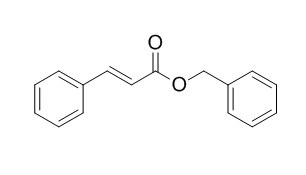Benzyl cinnamate
Benzyl cinnamate, a flavouring agent isolated from various plant species, is used in heavy oriental perfumes and as a fixative. Benzyl cinnamate has anti-inflammatory activity, it can treat trachoma, corneal opacities, Meniere's syndrome and tinnitus aurum.
Inquire / Order:
manager@chemfaces.com
Technical Inquiries:
service@chemfaces.com
Tel:
+86-27-84237783
Fax:
+86-27-84254680
Address:
1 Building, No. 83, CheCheng Rd., Wuhan Economic and Technological Development Zone, Wuhan, Hubei 430056, PRC
Providing storage is as stated on the product vial and the vial is kept tightly sealed, the product can be stored for up to
24 months(2-8C).
Wherever possible, you should prepare and use solutions on the same day. However, if you need to make up stock solutions in advance, we recommend that you store the solution as aliquots in tightly sealed vials at -20C. Generally, these will be useable for up to two weeks. Before use, and prior to opening the vial we recommend that you allow your product to equilibrate to room temperature for at least 1 hour.
Need more advice on solubility, usage and handling? Please email to: service@chemfaces.com
The packaging of the product may have turned upside down during transportation, resulting in the natural compounds adhering to the neck or cap of the vial. take the vial out of its packaging and gently shake to let the compounds fall to the bottom of the vial. for liquid products, centrifuge at 200-500 RPM to gather the liquid at the bottom of the vial. try to avoid loss or contamination during handling.
Drug Chem Toxicol.2024, 1-10.
Tumour Biol.2015, 36(9):7027-34
Food Addit Contam Part A.2021, 38(12):1985-1994.
Appl. Sci.2025, 15(1), 247
Oxid Med Cell Longev.2021, 2021:4883398.
Food Chem.2024, 436:137768.
Int J Biol Macromol.2021, 199:189-200.
Microchemical Journal2014, 203:110804.
Mol Med Rep.2022, 26(4):299.
Food Chem.2016, 191:81-90
Related and Featured Products
Harlem Hospital Bulletin, 1960, 1:97-102.
Benzyl cinnamate (Jacobson's solution) with vitamin A. A one-year experience in the treatment of cerebrovascular lesions.[Reference:
WebLink]
Benzyl cinnamate (Jacobson's solution) with vitamin A. A one-year experience in the treatment of cerebrovascular lesions.
Arch. Ophthalmol., 1936, 16(3):400-4.
BENZYL CINNAMATE IN THE TREATMENT OF TRACHOMA AND CORNEAL OPACITIES.[Reference:
WebLink]
In 1919 I introduced the use of Benzyl cinnamate in the treatment of tuberculosis. In order to inquire into the efficacy of this drug against tuberculosis, I used it first in the treatment of external forms of the disease, such as tuberculosis of the skin, mucous membranes and glands. These lesions being visible, it was easy to control and to follow the course of the disease. The results obtained proved worthy of interest and were confirmed by Darier and Jeanselme.1 My subsequent researches showed that the therapeutic action of the drug is not specific for tuberculosis.
CONCLUSIONS:
Its action can be seen wherever a focus of chronic inflammation is found, regardless of the nature of the agent which produces the lesion.It was by pure chance that Benzyl cinnamate found its application in the field of ophthalmology. While treating an Algerian Arab for glandular tuberculosis, I observed that while
US4587260[P]. 1986.
Dibenzalacetone and benzyl cinnamate as non-steroidal anti-inflammatory compounds and compositions thereof[Reference:
WebLink]
A non-steroidal anti-inflammatory composition comprising an active anti-inflammatory agent having the formula: ##STR1## wherein R is ##STR2## The active agent is formulated with a pharmaceutically acceptable carrier for use in the treatment of pain, inflammation and other related symptoms on mammals. Benzyl cinnamate and dibenzalacetone are preferred.
J Agric Food Chem. 2011 Jan 12;59(1):282-8.
Propolis specimens from different locations of central Italy: chemical profiling and gas chromatography-mass spectrometry (GC-MS) quantitative analysis of the allergenic esters benzyl cinnamate and benzyl salicylate.[Pubmed:
21126078]
Propolis is a beehive product popular in natural medicine thanks to its noteworthy properties.
Propolis is non-toxic but is responsible for allergic reactions in sensitive individuals.
METHODS AND RESULTS:
In this paper, we propose a new gas chromatography-mass spectrometry (GC-MS) analytical methodology for the quantitative analysis of two allergenic esters in propolis specimens, benzyl salicylate and Benzyl cinnamate, and test it on specimens from different locations of central Italy.
We also present the results obtained in the chemical characterization of the same specimens.
CONCLUSIONS:
The characterization showed that the resin fractions of all of the specimens are of poplar origin.



